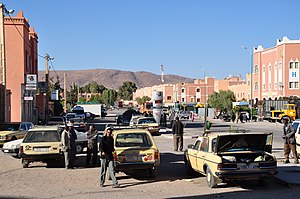Taznakht
| Taznakht تازناخت ⵜⴰⵣⵏⴰⵅⵜ |
||||
|---|---|---|---|---|
|
||||
| Basic data | ||||
| State : |
|
|||
| Region : | Drâa-Tafilalet | |||
| Province : | Ouarzazate | |||
| Coordinates | 30 ° 34 ′ N , 7 ° 12 ′ W | |||
| Residents : | 7,281 (2014) | |||
| Area : | 23.3 km² | |||
| Population density : | 312 inhabitants per km² | |||
| Height : | 1405 m | |||
| Taznakht - the townscape | ||||
Taznakht ( Arabic تازناخت; Taschelhit ⵜⴰⵣⵏⴰⵅⵜ ) is an oasis and an urban municipality with about 7,000 inhabitants in the province of Ouarzazate in the Drâa-Tafilalet region in southern Morocco . The spelling Tazenakht is sometimes used unofficially .
location
The small town of Taznakht, about 1400 m high, lies in a valley of the 1500 to 1800 m high mountains of the eastern foothills of the Anti-Atlas Mountains . It is located at the intersection of the N10 from Taroudannt (about 200 km west) or Ouarzazate (about 90 km northeast) with the R111 to Foum Zguid (about 85 km south) and the R108 to Agdz (about 88 km east). The sparse rain (approx. 115 mm / year) falls mainly in the winter months.
population
| year | 1994 | 2004 | 2014 |
| Residents | 3.813 | 6,185 | 7,281 |
The population of Taznakhts consists almost exclusively of members of various Berber tribes from the area. Most of them have migrated to the cities since the 1970s because of the lack of rain in their home villages, but also for socio-cultural reasons (hope for work, improvement in material living conditions and health care, better opportunities for schooling for their children, etc.).
economy
In earlier centuries self-sufficiency was at the center of economic activity. Only after the completion of several intersecting slopes in Taznakht (today asphalt roads) during the French colonial period , the food produced in the date palm oasis could also be sold on regional or national markets. At the same time, new vegetables (potatoes, tomatoes, etc.) came into the area and enriched the menu. Even today, the oasis economy dominates the life of most of the residents; Dates, olives, pomegranates and figs are primarily produced, but it is also possible to grow cereals (barley, wheat, corn) and vegetables (broad beans, carrots, tomatoes, etc.). In addition to agriculture, a number of small businesses have developed in the craft, business and service sectors.
history
As with all Berber villages, there is no written record of the history of Taznakht. However, it can be assumed that the palm oasis was discovered by early hunters and gatherers and many centuries later it was used by nomads to feed their cattle. Over time, some nomads settled down permanently and began farming ( barley , field beans, etc.) and planting trees ( pomegranate , figs , almonds ). The remaining livestock (donkeys, sheep, goats, chickens) could no longer roam freely, but had to be kept in pens or stables, which significantly reduced the population. In the phase of settling down , recurring and often violent conflicts between the oasis inhabitants and the migrating cattle nomads were not uncommon. Taznakht was a small Berber village well into the 20th century, which only developed into a small town in connection with the increased mobility of the inhabitants of the south.
Attractions
Apart from the impressive surrounding landscape (palm oasis in a stony mountain landscape) Taznakht offers no historical or cultural sights.
Web links
- Landscape between Taznakht and Agdz - photo
- Landscape near Taznakht with rainbow - photo
- Taznakht and surroundings, minerals, etc. - photos
- Taznakht and surroundings, minerals - information



